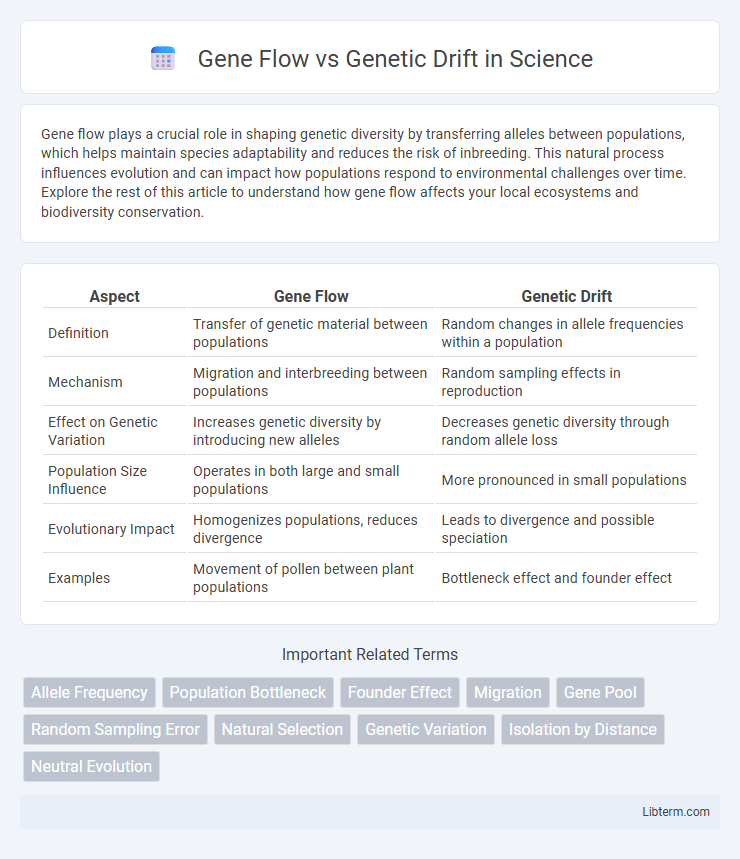Gene flow plays a crucial role in shaping genetic diversity by transferring alleles between populations, which helps maintain species adaptability and reduces the risk of inbreeding. This natural process influences evolution and can impact how populations respond to environmental challenges over time. Explore the rest of this article to understand how gene flow affects your local ecosystems and biodiversity conservation.
Table of Comparison
| Aspect | Gene Flow | Genetic Drift |
|---|---|---|
| Definition | Transfer of genetic material between populations | Random changes in allele frequencies within a population |
| Mechanism | Migration and interbreeding between populations | Random sampling effects in reproduction |
| Effect on Genetic Variation | Increases genetic diversity by introducing new alleles | Decreases genetic diversity through random allele loss |
| Population Size Influence | Operates in both large and small populations | More pronounced in small populations |
| Evolutionary Impact | Homogenizes populations, reduces divergence | Leads to divergence and possible speciation |
| Examples | Movement of pollen between plant populations | Bottleneck effect and founder effect |
Introduction to Gene Flow and Genetic Drift
Gene flow refers to the transfer of genetic material between separate populations, increasing genetic diversity and reducing differences among populations. Genetic drift involves random changes in allele frequencies, particularly in small populations, leading to loss of genetic variation over time. Both processes play crucial roles in shaping the genetic structure and evolutionary trajectory of populations.
Defining Gene Flow: Mechanisms and Examples
Gene flow refers to the transfer of genetic material between distinct populations through mechanisms such as migration, interbreeding, or pollen dispersal, which increases genetic diversity within populations. Examples include the migration of individuals from one population to another, resulting in the introduction of new alleles, or the cross-pollination between plant populations that shares genetic traits. These processes contrast with genetic drift, which involves random fluctuations in allele frequencies without gene exchange between populations.
Understanding Genetic Drift: Mechanisms and Examples
Genetic drift is a mechanism of evolution involving random changes in allele frequencies within a population, especially pronounced in small populations. It occurs through events such as the bottleneck effect, where a significant reduction in population size leads to loss of genetic variation, and the founder effect, where a new population established by a few individuals carries only a subset of the original population's genetic diversity. These stochastic processes can lead to significant evolutionary changes independent of natural selection, influencing traits and species diversity over time.
Key Differences Between Gene Flow and Genetic Drift
Gene flow involves the transfer of alleles between populations, increasing genetic diversity and reducing differences among populations. Genetic drift is the random fluctuation of allele frequencies within a population, often leading to reduced genetic variation and possible fixation or loss of alleles. While gene flow acts as a homogenizing force, genetic drift causes divergence, especially in small populations.
Effects on Population Genetic Diversity
Gene flow increases population genetic diversity by introducing new alleles from different populations, enhancing genetic variation and potentially increasing adaptability. Genetic drift reduces genetic diversity by causing random fluctuations in allele frequencies, which can lead to allele loss, especially in small populations. The contrasting effects of gene flow and genetic drift significantly influence evolutionary trajectories and population resilience.
Role in Evolutionary Processes
Gene flow introduces new genetic material between populations, increasing genetic diversity and reducing differences among populations, which can accelerate adaptation and counteract the effects of genetic drift. Genetic drift causes random changes in allele frequencies, especially in small populations, potentially leading to the loss of genetic variation and fixation of alleles independent of selective pressures. Both processes play crucial roles in evolutionary dynamics by shaping population structure and influencing the direction and rate of evolution.
Factors Influencing Gene Flow and Genetic Drift
Gene flow is influenced by factors such as migration patterns, geographic barriers, and population size, which determine the exchange of genetic material between populations. Genetic drift is primarily affected by population size, with smaller populations experiencing stronger random fluctuations in allele frequencies due to chance events. Environmental stability and reproductive isolation also play critical roles in shaping the extent and impact of both gene flow and genetic drift on genetic diversity.
Case Studies: Real-World Examples
Gene flow is exemplified by the interbreeding of African and European populations leading to increased genetic diversity, as observed in the Cape Verde Islands' human inhabitants. Genetic drift is highlighted in the case study of the northern elephant seal, whose population bottleneck drastically reduced genetic variation before a gradual recovery. These cases illustrate gene flow's role in promoting variation versus genetic drift's impact in causing random allele frequency changes within small populations.
Implications for Conservation and Biodiversity
Gene flow enhances genetic diversity by facilitating the exchange of alleles between populations, which can increase resilience and adaptability in endangered species. Genetic drift, especially in small populations, can lead to random loss of alleles and reduced genetic variation, increasing the risk of inbreeding depression and extinction. Conservation strategies must balance promoting gene flow to maintain genetic health while monitoring genetic drift to prevent loss of unique genetic traits essential for biodiversity.
Conclusion: Comparing the Impact of Gene Flow and Genetic Drift
Gene flow generally increases genetic diversity within populations by introducing new alleles, promoting adaptation and reducing genetic differences between populations. In contrast, genetic drift causes random fluctuations in allele frequencies, often reducing genetic variation and leading to population divergence, especially in small populations. The relative impact of gene flow and genetic drift depends on population size and connectivity, with gene flow dominating in large, interconnected populations and genetic drift having a stronger effect in isolated, small populations.
Gene Flow Infographic

 libterm.com
libterm.com